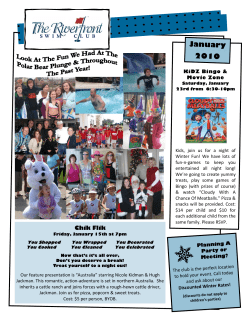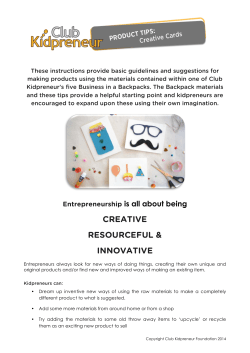
‘How to’ Funding Guide BBC Children in Need (Main grants)
‘How to’ Funding Guide ‘How to’ Funding Guide Specific to: BBC Children in Need (Main grants) IRFU (ULSTER BRANCH) David Johnston Club & Community Development Officer 028 9049 3111 ext 257 david.johnston@ulsterrugby.com January 2014 1 ‘How to’ Funding Guide Table of Contents Section Page Number 1. INTRODUCTION 3 2. OVERVIEW 4 3. KEY POINTS 7 4. EXAMPLE PROJECTS 11 2 ‘How to’ Funding Guide SECTION 1 – INTRODUCTION IRFU (Ulster Branch) have developed this ‘How to’ funding guide as a resource to provide a succinct support mechanism for Clubs wishing to apply for grant funding. Each ‘How to’ funding guide has been developed for a specific grant programme, details of which are within the document. Disclaimer IRFU (Ulster Branch) have developed this resource in good faith and have endeavoured to ensure that the information contained within is accurate at date of production. Clubs are responsible for ensuring that information contained within their own submission meets the up to date requirements of the grant programme. 3 ‘How to’ Funding Guide SECTION 2 – OVERVIEW Grant Programme Name: Children in Need (Main grants) Link to Grant Programme website: http://www.bbc.co.uk/programmes/b008dk4b/features/grants Introduction The BBC Children in Need Main Grants programme is open to charities and not-for-profit organisations (including sports clubs) applying for grants over £10,000 per year for a maximum of 3 years. Grants are provided for organisations working with children and young people of 18 years and under experiencing disadvantage through: Illness, distress, abuse or neglect Any kind of disability Behavioural or psychological difficulties Living in poverty or situations of deprivation BBC Children in Need fund organisations working to combat this disadvantage and to make a real difference to children and young people’s lives. Deadlines: See the table below for more information. There are 3 deadlines throughout the year. Application What Happens Next When is the Deadline Decision Due? th If your initial application is invited to the next stage you will Mid October 15 May 15th September 15th January need to complete a full application form. You will hear whether you have been invited to do this a couple of weeks after you have submitted your initial application and you’ll Mid February have a month to complete a full application to be considered in the next round. You will need to be available in the month after you submit Mid June your full application for a telephone assessment. Your referee will also need to be available during this time to provide a reference. 4 ‘How to’ Funding Guide Amount Organisations can apply for grants over £10,000 per year for up to 3 years. There is no upper limit for Main Grants but Children in Need make very few grants over £100,000 and most grants are for much less. Requests for larger amounts are always more competitive. What grants are NOT provided for: Work which statutory bodies (such as schools or local authorities) have a duty to fund Building projects applying to Children in Need for more than £20,000 Projects which promote religion Trips or projects abroad Medical treatment or research Pregnancy testing or advice, information or counselling on pregnancy choices Awareness-raising work, except where it is targeted at those children or young people most at risk. Bursaries, sponsored places, fees or equivalent Individuals (unless an eligible organisation is applying on their behalf) Organisations that apply on behalf of other organisations, for example, PTA’s applying on behalf of schools General appeals or endowment funds Budget shortfalls or debt repayments Projects where the grant expenditure is due to start before the grant award date (retrospective funding) Projects unable to start within 12 months of the grant award date Unspecified expenditure Organisational overheads or running costs which the organisation would incur whether the project was running or not, however, support costs incurred as a direct result of running a project will be considered. Refer to the online A-Z Guidance to make sure you don’t waste time applying for things that will not be funded. Follow this link for the guidance http://www.bbc.co.uk/programmes/b008dk4b/features/cin-grants-main-index 5 ‘How to’ Funding Guide How to apply Read through the guide to ‘planning your project’ at the following link. This provides very useful information and will help your Club develop a strong application. http://www.bbc.co.uk/programmes/b008dk4b/profiles/planning-your-project There is a two stage application process for the Main grants programme. Use the online application system to complete an Initial Application and to submit additional information. This can be accessed by following this link and clicking on the ‘application form’ box http://www.bbc.co.uk/programmes/b008dk4b/features/cin-grants-main-index Supporting documents All Clubs must submit the following supporting documents with their application form, via the online application system: Most recent set of annual accounts o If your most recent accounts are more than 18 months old you must also provide draft accounts which provide a more recent update. Governing document, e.g. constitution If you are applying for a main grant (over £10,000) you will also need to send a Job Description, Person Specification and Work Plan for every salaried or sessional post you are applying. Notes If your Club currently has a grant from Children in Need, you can apply for further funding providing your current grant is coming to an end within the next 12 months. Refer to the FAQs section for advice and other information: http://www.bbc.co.uk/programmes/b008dk4b/features/cin-grants-main-index 6 ‘How to’ Funding Guide SECTION 3 – KEY POINTS The following section outlines the key points for your Club to consider when completing the main questions in the application form. Please do not complete your answers in this document – this is for guidance only. The official Main grants application form can be found on the BBC Children In Need website by following the link on page 6 of this document. Please do not copy and paste content from this document into your application form. This is simply to provide examples and guidance only. Your answers should be relevant to your project and the needs of the children/young people you are working with. Main Grants Form - Main Questions and associated Answers Please describe the purpose and activities of your organisation (max 200 words). Provide a brief snapshot of your Club including the following details: Date of establishment Brief overview of the Club’s aims and objectives Breakdown of the Club’s team structures and playing members including under age teams, disability sections, female sections if relevant. What current sporting activities are offered and what are the benefits e.g. improving physical and mental health; providing a social outlet; improving discipline, dedication, initiative etc; enhancing communications skills, leadership, teamwork etc; Detail of other community activities offered on top of the regular training and competition eg, open days, fetes, Club festival/bbq, ‘come and try it’ events, educational classes, good relations activities etc Details of any partnerships the Club has developed or is involved in. This could be with other sports clubs, community groups, statutory organisations etc Details of any cross community or cross border partnerships the Club is involved in. Please describe the disadvantages experienced by the children and young people you work with, and how they are affected (max 200 words). Use the Club’s experience and local knowledge to describe the challenges and deprivation that the children and young people face e.g. anti-social behaviour, crime, unemployment, religious/political tensions, poor educational attainment, behavioural difficulties, family issues, disabilities etc. The use of local case studies such as media reports is also good to provide a reality and to show evidence. Make use of statistics from NISRA (Northern Ireland Statistics and Research Agency) which represent multiple deprivation relating to an address or postcode (if you are 7 ‘How to’ Funding Guide unsure of how to gain statistics from NISRA, contact David Johnston, Club & Community Development Officer) Make use of statistics from the PSNI Statistics website Include how the disadvantage experienced by the children and young people has an impact upon them, e.g. depression, anxiety, poor health, low confidence, lack of respect/trust for others, negative attitudes, no enjoyment/fun, lonely etc. The more information you can include, the better. Please describe the activities or services you are asking us to fund (max 200 words). This question provides you with an opportunity to tell Children in Need exactly what your project will do. You need to give as many specific details as possible associated with your project. Examples of information you could include: Exactly what activities will take place – detailed description Include the duration of project, start and end dates, frequency (once/week, twice/month etc), who the target participants are, participant age groups etc Project location Include the numbers of participants that will take part in the project. Who will be delivering each type of activity What resources are you applying for to enable the activities to take place These activities should be designed to address the disadvantages of the children and young people as described in the second Question. How will these activities or services address the disadvantages the children and young people are experiencing (max 200 words)? This question lets you explain how the activities within your project are best suited to deal with the disadvantage the children and young people are facing (as per the second Question). The answer here will be specific to the needs of the participants as well as the activities that will be delivered throughout the project. For example, if you have identified that two of the main needs of the children and young people are anti-social behaviour and drug & alcohol abuse, and assuming the project involves a drug & alcohol awareness workshop and a programme of rugby activities, try to explain what positive impact a drug and alcohol awareness workshop will have and how taking part in the rugby activities will help to reduce anti-social behaviour, i.e, by channelling aggression, providing an alternative motivation and direction for the participants, gain respect for others and improve dedication and self-discipline. 8 ‘How to’ Funding Guide How have the children and young people influenced how you planned this project, and how will they continue to be involved in the running and development of the project (max 200 words)? Children in Need want to see that the children and young people involved in the project have some sort of proactive role in the planning and delivery of the project. This involvement could include for example: XX RFC operates for the benefits of the children and young people it caters for and as such, all projects and activities are tailored to meet the needs of these children and young people. Networking, interfacing and consulting with the children and young people on a weekly basis has contributed towards the design and delivery methods of this project. Volunteers at the Club continuously consult with local young people and are aware of their specific needs and issues Our Club has consulted with the parents of the children and young people and received input via this indirect method of communication. During Clubs activities, the Club volunteers informally consult with the children and young people to gauge their views and opinions regarding the direction the project should take. Whilst expert facilitators/coaches will be leading the project, the children and young people will be given certain roles and responsibilities, such as filling up water bottles, placing equipment and assisting in the co-ordination and delivery of some of the activities. Some of the young people could manage the project budget, with assistance from adult volunteers. We have targeted the contribution of children and young people in the planning and delivery of this project as much as is realistically possible. How will you make sure that you reach those children and young people who would most need or benefit from your project (max 200 words)? Explain in this answer how the Club will raise awareness of the project so that all potential participants can avail of the project activities. Some examples could include: Details distributed during Club activities to children, young people and parents/guardians Details distributed across local schools, community groups and youth sector organisations in key areas/locations Club website Club social media Project activities have been designed with accessibility for all children and young people, taking into consideration specific needs and issues that otherwise might have hindered some from participating. 9 ‘How to’ Funding Guide You have told us about the activities you plan to run. Please describe the three most important differences these activities will lead to in the lives of the children and young people you work with (max 200 words for each difference). Example Difference: Through planning the project and managing the budget, the young people will become more confident in putting their views across and making decisions which will help them to live more independently. For each difference, Please describe what evidence you will collect to tell you this difference has been made (such as statistics, feedback, observations etc.) (max 200 words for each difference). Example Evidence: A Personal Progress Plan establishes a starting point for each young person, and tracks their progress through observations and feedback from the young people and their parents/carers. We understand that the three differences you have described above may not show the full picture of what your project will achieve for children and young people. Please tell us about any other differences (outcomes) you expect the children and young people to experience (max 200 words). In addition to the 3 differences/outcomes you have listed above, include details of more differences/outcomes that the project will achieve. The differences/outcomes will be specific to each Club and will relate to the need identified amongst the participants and the project and associated activities in question to help address this need/disadvantage. Some example differences could include: Skills set including co-operation, teamwork, leadership, communication skills. Building of friendships, trust, mutual respect for other children and young people from across the religious divide. Improvements in physical and mental well-being Healthy eating habits Self-confidence, positive social change Alternative motivation as opposed to anti-social behaviour Dedication, discipline, controlled aggression 10 ‘How to’ Funding Guide SECTION 4 – EXAMPLE PROJECTS If applying for a main grant, it is even more important that your project is well thought out and planned to meet the needs of the children and young people that will be involved. Make sure you read through the ‘planning your project’ section as this will help you create a strong application - http://www.bbc.co.uk/programmes/b008dk4b/profiles/planningyour-project Also, make sure you read through the A-Z Guidance to make sure you only apply for things that Children in Need can fund http://www.bbc.co.uk/programmes/b008dk4b/features/cin-grants-main-index If you require clarification on a project idea, please contact David Johnston (IRFU Ulster Branch, Club & Community Development Officer) via phone or email. Office telephone – 02890 493111 ext 257 Mobile telephone – 07767168981 Email – david.johnston@ulsterrugby.com 11
© Copyright 2025




















